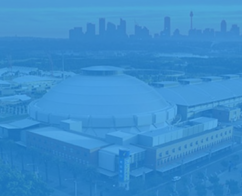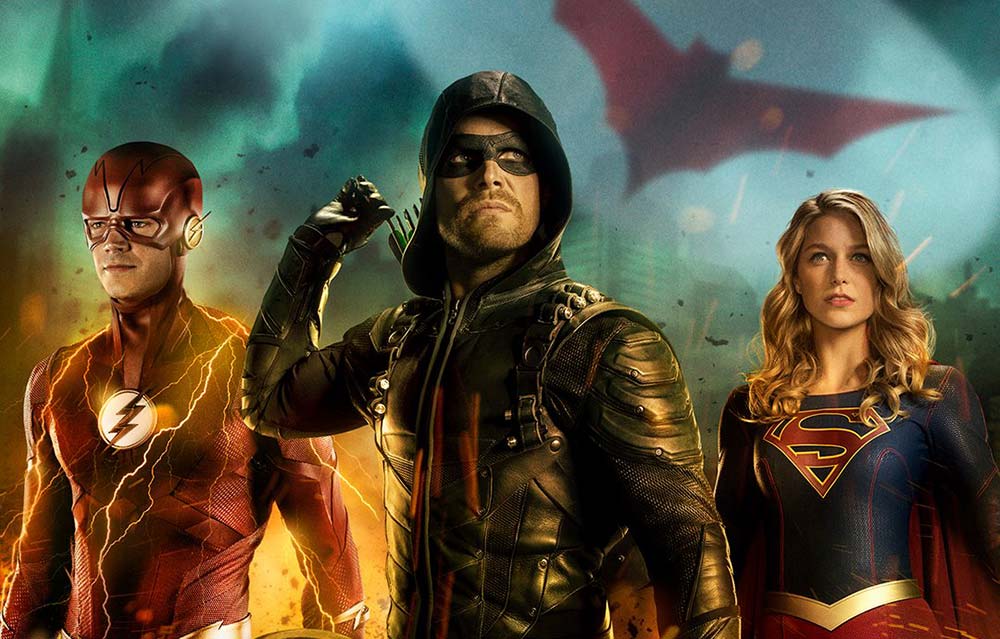
Sydney
June 22-23, 2024
Sydney Showground Olympic Park



Seven years since its inception, CW’s Arrowverse is collectively enjoying something of a renaissance.
The show that gave the interconnected stable of series its name, Arrow, and its first spin-off, The Flash, are both turning in their strongest seasons in at least a couple of years, after enduring some, shall we say, rocky midlife crises on each of their parts along the way.
Additionally, Supergirl – as of the recent Elseworlds crossover – has, for now, solved its Superman problem. Supa-Star Tyler Hoechlin is an alarmingly charismatic Kal-El, and his chemistry and rapport with the newly established Lois Lane (Bitsie Tulloch) are so natural, you’d be forgiven for wanting the show to refocus its narrative on them instead.
By stashing Clark and the newly introduced Lois on a far-off planet to see out Lois’ pregnancy, it puts two overbearing forces at great enough a distance to no longer run the risk of undercutting Kara’s – and Melissa Benoist’s – importance on her own show.
And, against all odds, Legends of Tomorrow has continued to outdo itself as the shining star of the entire line, having well outgrown its tepid first season to embrace the inherent wackiness of its core concept to become a consistently entertaining, outlandish, progressive and downright joyous ode to silly super-science and superhero shenanigans, and the best show of the bunch.
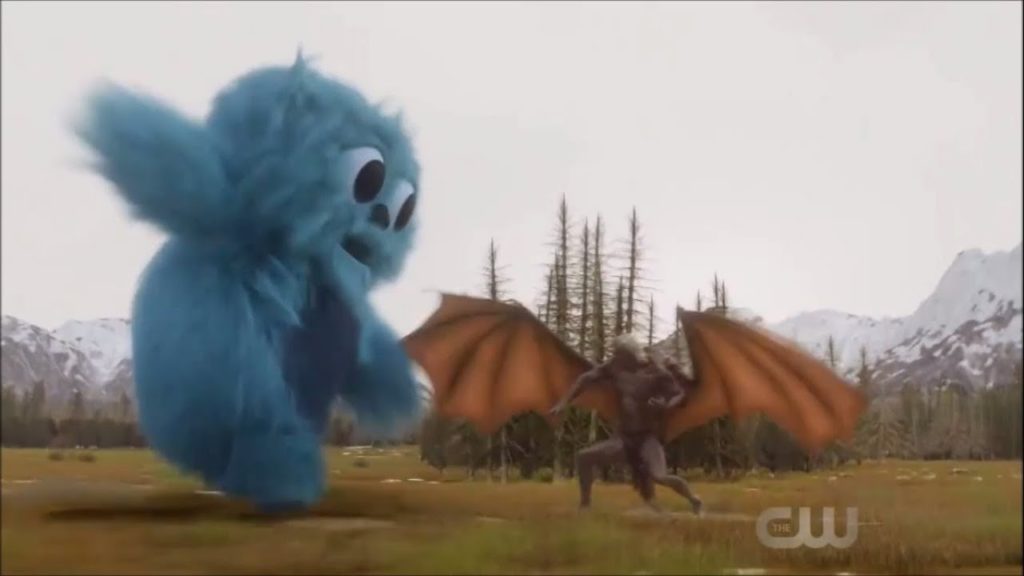
Pictured: Uh, only the best show on television. (Photo: YouTube)
So, with all four series currently on hiatus following the aforementioned Elseworlds three-parter (Legends abstained from the crossover this year, a fact gloriously referred to by Nate (Nick Zano) and Ray (Brandon Routh) in a typically meta piece of back-and-forth), it’s worth casting eyes forward to what may yet lie ahead for the heroes of the Arrowverse.
Crisis on Infinite Earths
We should get this bit of news out of the way first and foremost: as announced at the conclusion of Elseworlds, next year’s crossover will adapt DC’s seminal 1985 event, Crisis on Infinite Earths. There are a couple of important takeaways here.
Chiefly, the key piece of information that can be gleaned from Crisis is that Arrow, The Flash, and Supergirl are all exceptionally likely to be renewed for their eighth, sixth and fifth seasons, respectively. So that’s good news, for starters.

Can’t have a crossover if there aren’t any shows to cross over.
But it could also signify a huge shift in-story, too. In case you haven’t read the original Crisis series – and, frankly, no one would blame you, because it is an abnormally impenetrable book for new and longtime fans alike – the very basic gist is that DC, feeling bogged down by years of continuity, commissioned the event to merge their multiple universes into one, sort-of streamlined universe with a single, shared history.
As we know, the present Arrowverse is made up of an ever-growing number of different worlds – Supergirl takes place on Earth-38, for example, away from the adventures of Teams Arrow and Flash on Earth-1; could the televised Crisis be making way for the merging of Kara’s world with ours?
Elements of the story already made their way into Elseworlds: we saw the introduction of cosmic being The Monitor (LaMonica Garrett), Earth-90’s Flash (John Wesley Shipp) sought to warn our heroes of his coming – echoing Barry Allen’s comic-book caution of impending disaster to Batman – and both Supergirl and Flash were (almost, in the shows’ case) killed saving the world. Also, Psycho Pirate (Bob Frazer) was there.
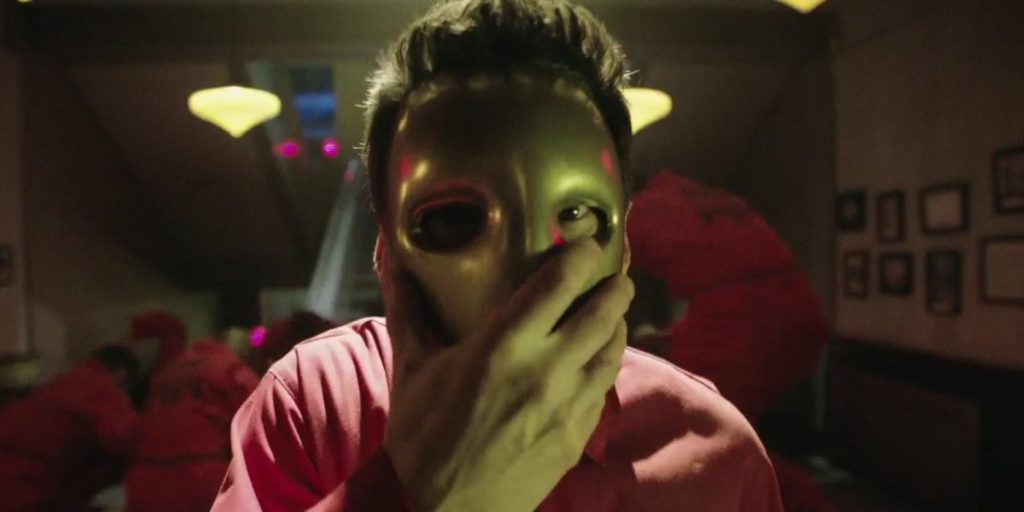
Good for Psycho Pirate. (Photo: CW)
With the series already being so liberal with torn-from-the-pages references and inspiration, it’s not inconceivable that the Crisis event will make use of the cosmos-shifting ramifications to tidy itself up as a way of refreshing – or even possibly retiring – the universe.
That’s all not to mention the other elephant in the room – the nascent streaming DC Universe of shows, which has already begun with the acclaimed Titans and is set to expand with shows dedicated to the Doom Patrol and Stargirl; as well, we’ve seen the recent apparent clearing of the decks over at Netflix, cancelling its Marvel series as rival streaming service Disney+ stakes its claim of ownership. It’s entirely possible that, in Crisis, we’re seeing a similar endgame strategy for the CW as DCU looks to use more of its well-known characters to boost its own standing in the market.
So, where does that leave us?
Outing Oliver Queen (Stephen Amell) and jailing him for his years of vigilante activity was probably the smartest move Arrow could make this far into its run. The shift in status quo made room for the arrival of Ollie’s half-sister, and new Green Arrow, Emiko Queen (Sea Shimooka). Since ditching its well-established flashback framework, the show has since given us glimpses at events 20 years hence among the present-day drama, revealing the fates of characters such as Roy Harper (Colton Haynes), and Oliver’s adult son, William (Ben Lewis). And, in Elseworlds, Ollie made a deal with The Monitor to spare Barry and Kara; it’s not too great a leap to suggest that the sacrifice he offered in place of their lives was his own.
In essence, the show – if it’s looking to run past next season – seems to be preparing for a future without Oliver Queen.
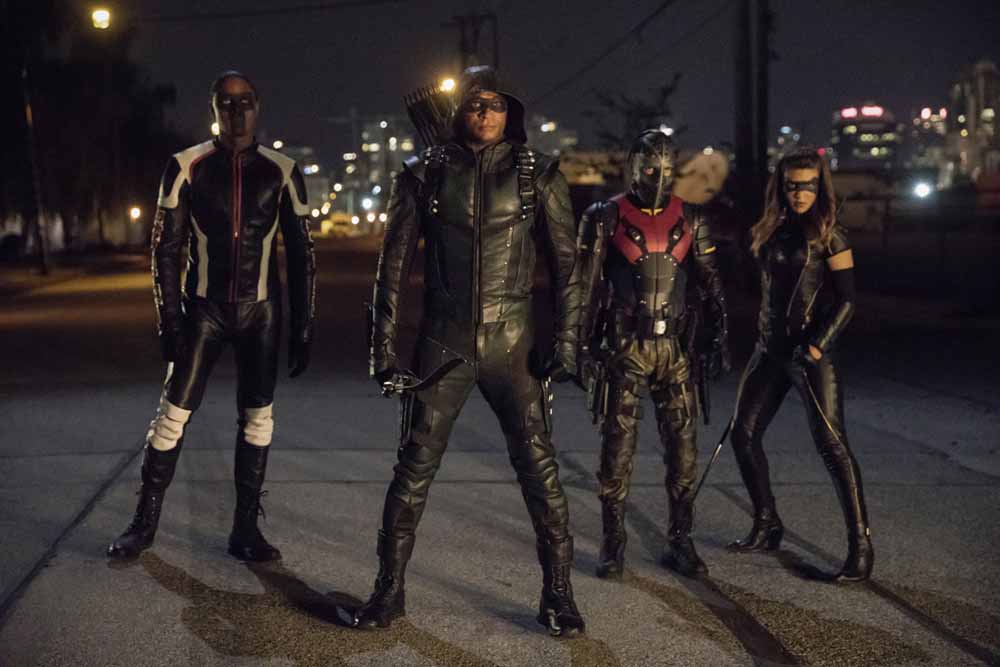
“Hear me out: we could be called ‘Wild Dog and Friends’! Guys?…Hey, guys?” (Photo: CW)
With that in mind, it’s possible that we’ll see an increasingly reckless Ollie on the way to Crisis, and whether whatever happens to him during that journey is a catalyst for future plans by Felicity (Emily Bett Rickards), revealed in this season’s flash-forwards, to casually level Star City. If Stephen Amell were to use Crisis as a point to exit the universe he was so crucial in establishing, with eight years of lore behind it, Arrow is well placed to move forward with its supporting cast, especially with Emi filling the Green Arrow quiver – but, equally, if there was ever a time for the series to hang up the Hood for good and look back on its works with pride, that would be it.
As much as Oliver Queen is connected to Crisis, Barry Allen (Grant Gustin) has been too – since his very first season, in fact. In Year One, we were introduced to the so-called ‘Crisis’ during which The Flash was projected to disappear one day. Though the article, written by Iris (Candice Patton) is dated 2025, there’s nothing that suggests the timeline – already affected by the arrival of Barry and Iris’ daughter, Nora (Jessica Parker Kennedy) – is impervious to future disruption, especially following the revelation that Nora’s strings are being pulled by Barry’s long-time nemesis, Eobard Thawne (Reverse-Flash).
The reintroduction of Tom Cavanagh’s Thawne-Wells hybrid is a welcome delight and, amazingly, the prospect of another speedster villain doesn’t seem anywhere near as exhausting as it would have a year ago (probably because The Thinker arc was so slow in, like, every regard).
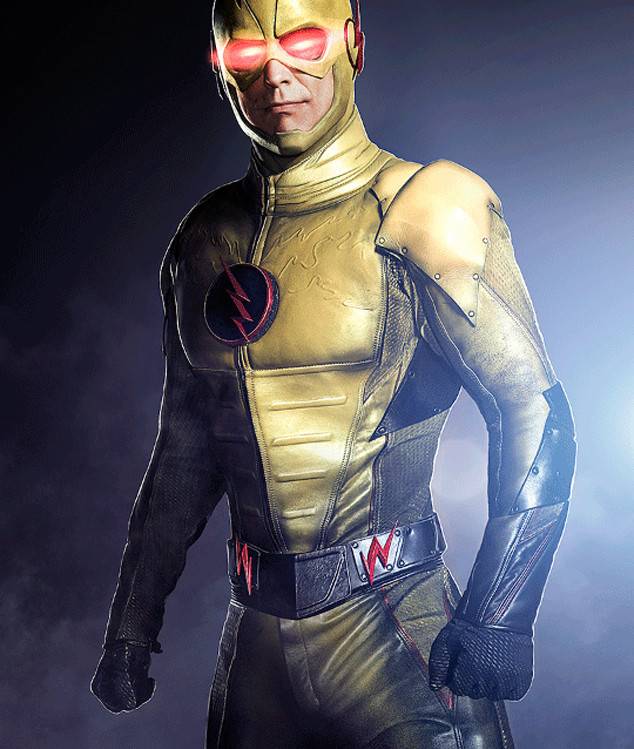
Welcome back, you magnificent beast. (Photo: CW)
It would be a fitting way for the show to come full circle to have The Flash and his original antagonist clash once more in a final battle for supremacy ahead of potentially one of the defining moments of Barry Allen’s life, setting a fresh stage for the post-Crisis status quo – or, if it comes to it, serving as an apt swansong for the Scarlet Speedster, given comic-book Barry’s fate back in 1985.
Whether or not Supergirl’s world merges with Earth-1 as a result of the impending Crisis doesn’t really matter; the show has survived on its own (mostly) without issue for its three-and-a-half-season run, and with last season’s introduction of the 31st century’s Legion of Superheroes opening up a whole new time period of adventures to explore – perhaps worthy of a spin-off in its own right – there’s plenty of material to help it sustain itself even without an integrated continuity with its sister shows, should there be a post-Crisis Arrowverse left standing.
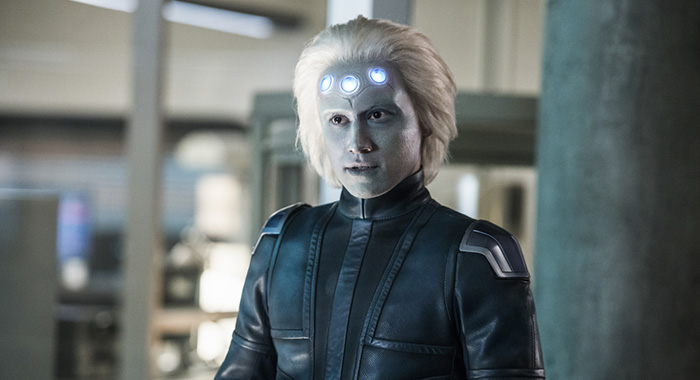
The 31st century! Exciting new ground! Like… what if Braniac was… uhhh… good? (Photo: CW)
If that is the case, though, the main area where Supergirl could stand to benefit – especially with Big Blue now tucked away among the stars – would be to dial back its reliance on Superman villains (hello, Manchester Black) and story arcs (which tends to make Supergirl little more than an empty surrogate) and to really forge new ground for Kara Zor-El, well and truly out from her cousin’s shadow, where she can bask in the full glory of Earth’s yellow sun.
Alternatively, if Earth-38 does merge with Earth-1 and Batwoman doesn’t get picked up as a solo series off the back of her introduction in Elseworlds, it would be a perfect opportunity to bring the character into Supergirl and get some more World’s Finest adventures out of the whole deal. We could live with that.
Interestingly, although Legends is technically set on Earth-1, it too shares very little in common with Arrow, The Flash and even Supergirl. As executive producer Keto Shimitzu recently said, the show is now so tonally different from the rest of the Arrowverse as to make its inclusion in Elseworlds more laborious than it ought to be. But that’s fine, too: Legends works so well because its team of miscreants, misfits and magical beings feels so isolated from everyone else – adrift in time, more at home floating in the temporal zone than they are in any permanent residential structure, no matter what new Time Bureau employee Nate (Nick Zano) is telling himself.
The addition of Matt Ryan’s Constantine has been a particular joy to watch this season, in some ways giving him the second season his ill-fated solo show so sorely deserved. He’s a natural fit on the Waverider, and hopefully the character hangs around for longer than this run of episodes if given the opportunity. It’s obvious he’ll be pretty central to the season’s second half, being the target of ire for newly unveiled big bad demon Neron.
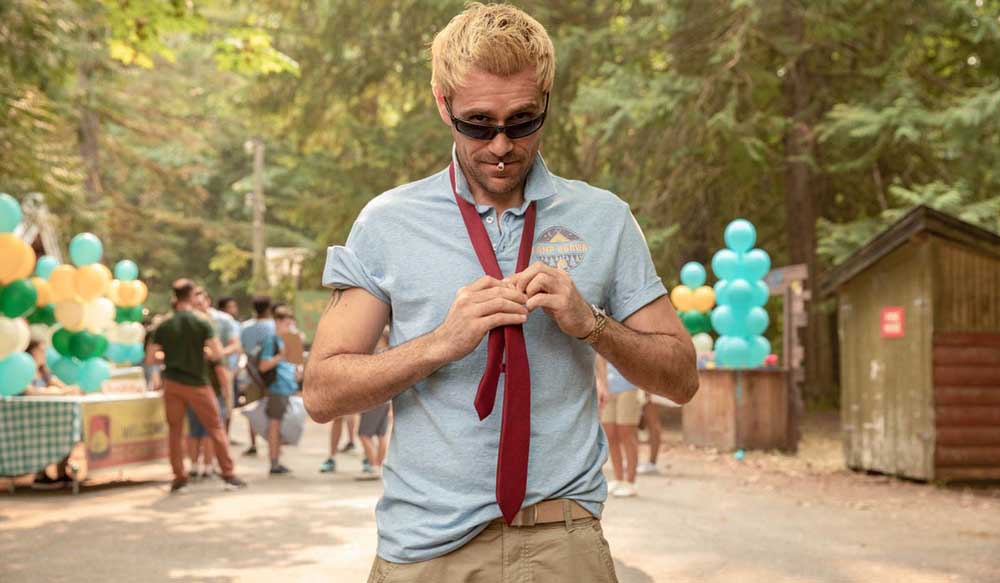
I never knew how much I needed this until I got it. (Photo: CW)
The entire ensemble works as beautifully together as it ever has, from the core team – Zari (Tala Ashe) has been a notable standout, as have Dominic Purcell’s Rory and Maisie Richardson-Sellers’ Charlie – right down to growing characters such as the eternally chipper Gary (Adam Tsekhman) and magical-creature fanatic Mona (Ramona Young). Both Nick Zano and Brandon Routh bring boundless enthusiasm to their roles as best bros Nate and Ray, and Caity Lotz, of course, remains the heart of the series in more ways than one, her role as Captain and burgeoning relationship with Time Bureau director Ava Sharpe (Jes Macallan) highlighting her growth from reanimated, soulless assassin to cherished, intrepid defender of space and time.
If any CW series should survive the effects of Crisis on Infinite Earths, it’s Legends of Tomorrow, but even this beloved crew seem to be acutely aware that all good things must end. Amid all the heightened insanity of season four’s high-jinks to date, there has been an occasionally fatalistic undertone to some of the writing this year. Long-time member Nate has ostensibly retired from the ship to take up a more stable existence in the present and, when he visits the ship, he makes a comment about enjoying good times while they last.
Whether this is merely in-story philosophy or a more meta reflection of Legends’ own lifespan is moot. But, then again, midseason finale Legends of To-Meow-Meow spent its runtime literally killing the team over and over. Hey, fingers crossed it all works out – it always does for the Legends.
Right?
Arrowverse stars Matt Ryan (Legends of Tomorrow) and Tyler Hoechlin (Supergirl) will appear at Supanova Comic Con & Gaming Melbourne (6-7 April) and Gold Coast (13-14 April).
